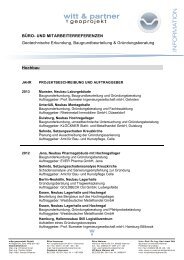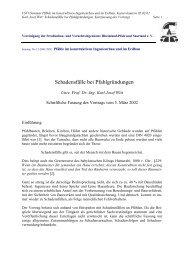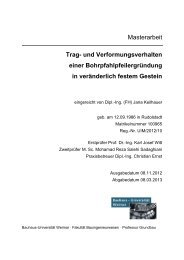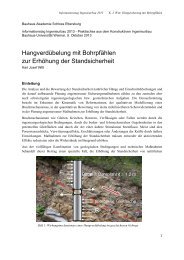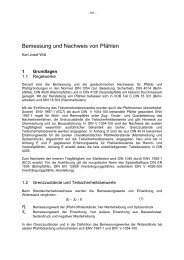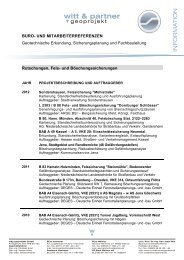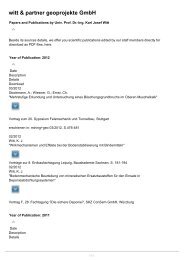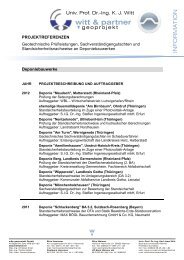A Static Analysis of Hydraulic Heave in Cohesive Soil - witt & partner ...
A Static Analysis of Hydraulic Heave in Cohesive Soil - witt & partner ...
A Static Analysis of Hydraulic Heave in Cohesive Soil - witt & partner ...
You also want an ePaper? Increase the reach of your titles
YUMPU automatically turns print PDFs into web optimized ePapers that Google loves.
with the simplified formula:<br />
p<br />
*<br />
= σ ' + σ<br />
(5)<br />
t<br />
Figure 4. Different failure modes <strong>in</strong> cohesive soils [9]<br />
soils, will fail <strong>in</strong> range <strong>of</strong> a comparatively small hydraulic<br />
gradient, while the critical gradient <strong>in</strong>creases proportional<br />
with a ris<strong>in</strong>g cohesion and under the limit state <strong>of</strong> a<br />
constant friction angle and a equivalent pore diameter.<br />
All <strong>of</strong> the mentioned <strong>in</strong>vestigations <strong>in</strong>dicate that erosion<br />
failure due to a drop <strong>of</strong> hydraulic potential is only<br />
probable <strong>in</strong> soils with very small cohesion. Already <strong>in</strong><br />
cohesive soils a wedge failure mechanism with discrete<br />
elements or clods will be relevant. As demonstrated <strong>in</strong><br />
Fig. 4, soils with low cohesion will qualitatively fail as a<br />
certa<strong>in</strong> k<strong>in</strong>d <strong>of</strong> erosion (liquefaction) while soils with<br />
higher cohesion will fail due to a development <strong>of</strong> discrete<br />
shear planes as wedge failure mechanism or as a uplift <strong>of</strong><br />
discrete cracked layers. A semi quantitative analysis<br />
shows the possibility <strong>of</strong> a failure due to erosion up to a<br />
cohesion <strong>of</strong> approximately c’ ≤ 2,5 kN/m². <strong>Soil</strong>s with<br />
higher cohesion will fail <strong>in</strong> a more complex dimension<br />
after manifestation <strong>of</strong> a shear zone. Nevertheless for<br />
<strong>in</strong>itiat<strong>in</strong>g a wedge failure, discrete shear zones or <strong>in</strong>itial<br />
cracks are necessary to develop a pre-failure state. In case<br />
<strong>of</strong> a progressive development <strong>of</strong> dom<strong>in</strong>antly horizontal<br />
cracks the post failure conditions are equal to vertical<br />
uplift.<br />
Therefore <strong>in</strong> cohesive soils a wedge failure mechanism<br />
can be described by us<strong>in</strong>g the theory <strong>of</strong> effective stresses<br />
Accord<strong>in</strong>g to that a failure occurs if there is no effective<br />
stress σ’ and the excess pore water pressure p* is higher<br />
than the tensile strength σ t with<strong>in</strong> the soil cont<strong>in</strong>uum.<br />
Fig. 5 shows three different shaped failure bodies to<br />
f<strong>in</strong>d an upper bound or limit state due to a wedge failure<br />
mechanism on a sheet pile wall as a support <strong>of</strong> an<br />
excavation. Besides the consideration <strong>of</strong> rectangular,<br />
triangular and parabolic shaped bodies (I, II and IIIa) there<br />
are two different ways to build equilibrium <strong>of</strong> forces. At<br />
first the undra<strong>in</strong>ed cohesion c u can be considered as the<br />
representative resistance <strong>in</strong> a slip plane at limit state (see<br />
failure body I to IIIa). On the other hand the resistance at<br />
the stadium right before failure can be assumed by tak<strong>in</strong>g<br />
the achievable tensile strength <strong>of</strong> the soil <strong>in</strong>to<br />
consideration. The result<strong>in</strong>g equilibrium <strong>of</strong> forces is<br />
illustrated <strong>in</strong> Fig. 5 as failure body III b.<br />
The thickness <strong>of</strong> a failure body with the slightest safety<br />
aga<strong>in</strong>st hydraulic heave is described by the factor<br />
b = m · t. The shape and therefore m depends significant<br />
on the flow net. Assum<strong>in</strong>g a small embedd<strong>in</strong>g and a<br />
correspond<strong>in</strong>g flat shape <strong>of</strong> the flow net a relative broad<br />
area <strong>of</strong> <strong>in</strong>fluence will be developed. Reason for this is the<br />
<strong>in</strong>cl<strong>in</strong>ation <strong>of</strong> the flow forces. In such a case the thickness<br />
complies with m = 1/2 suggested by Terzaghi respectively<br />
b = 1/2 · t. If the embedd<strong>in</strong>g reaches deeper <strong>in</strong>to the<br />
ground the flow net will be orientated more vertical and<br />
the values <strong>of</strong> the parameter will be from approximately<br />
m = 1/3 to m = 1/4.<br />
The failure body IIIa shown <strong>in</strong> Fig. 6 describes the<br />
failure mechanism <strong>of</strong> a hydraulic heave <strong>in</strong> the most<br />
probable way. The parabolic surface <strong>of</strong> the failure body<br />
corresponds with the flow l<strong>in</strong>es <strong>of</strong> the flow net and<br />
therefore with the direction <strong>of</strong> flow <strong>in</strong>duced shear forces.<br />
In case <strong>of</strong> shear planes the residual shear strength<br />
represented by the undra<strong>in</strong>ed cohesion c u will be activated.<br />
Symbols: C u – vertical part <strong>of</strong> the force from undra<strong>in</strong>ed cohesion, G’ – dead load under uplift, S – stream<strong>in</strong>g force,<br />
Z – tensile force over width <strong>of</strong> the failure body, ∆h u – potential difference, m · t – width <strong>of</strong> the failure body<br />
Figure 5. Different types <strong>of</strong> wedge failure [9]



